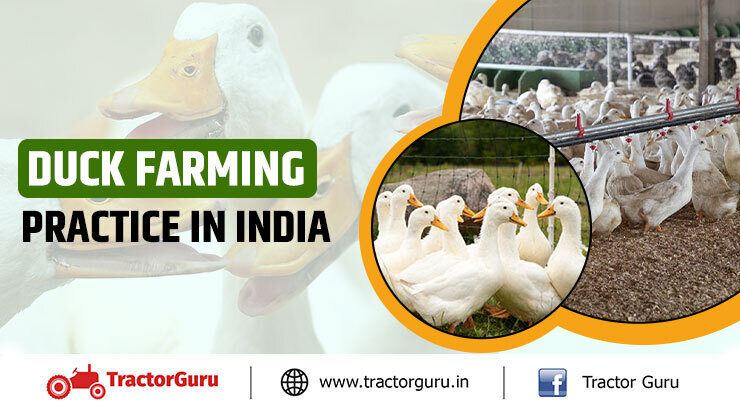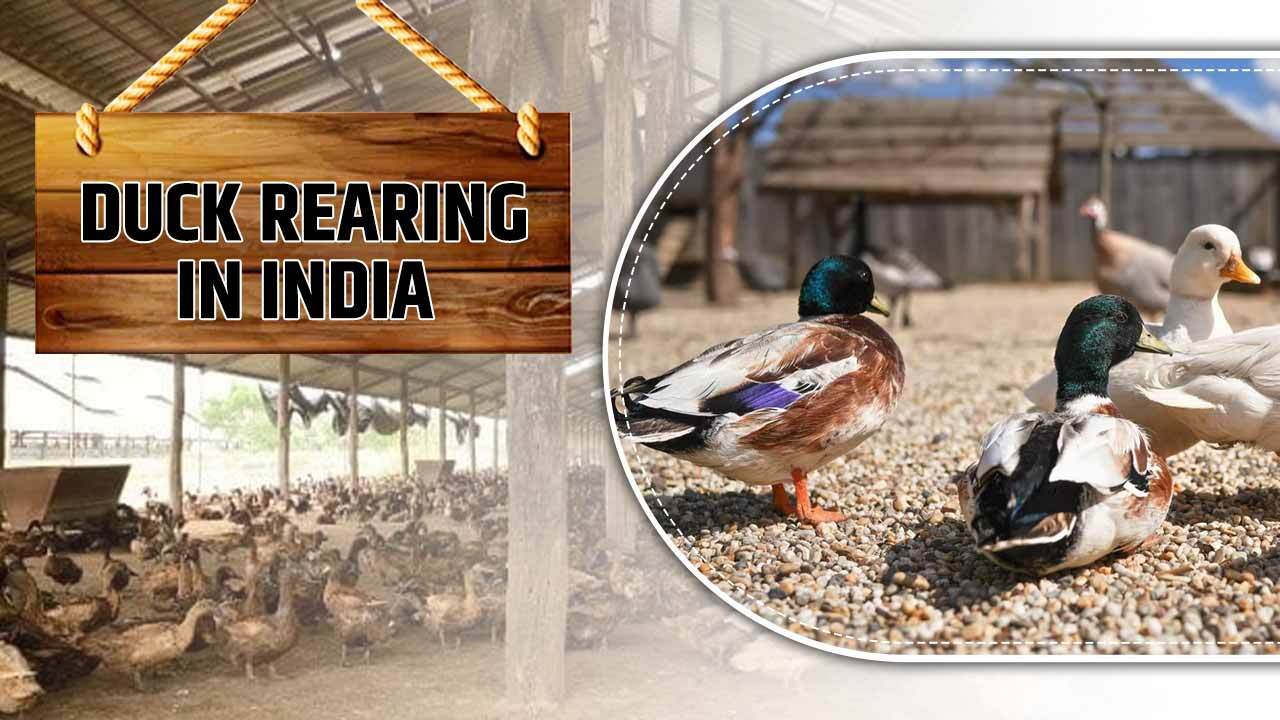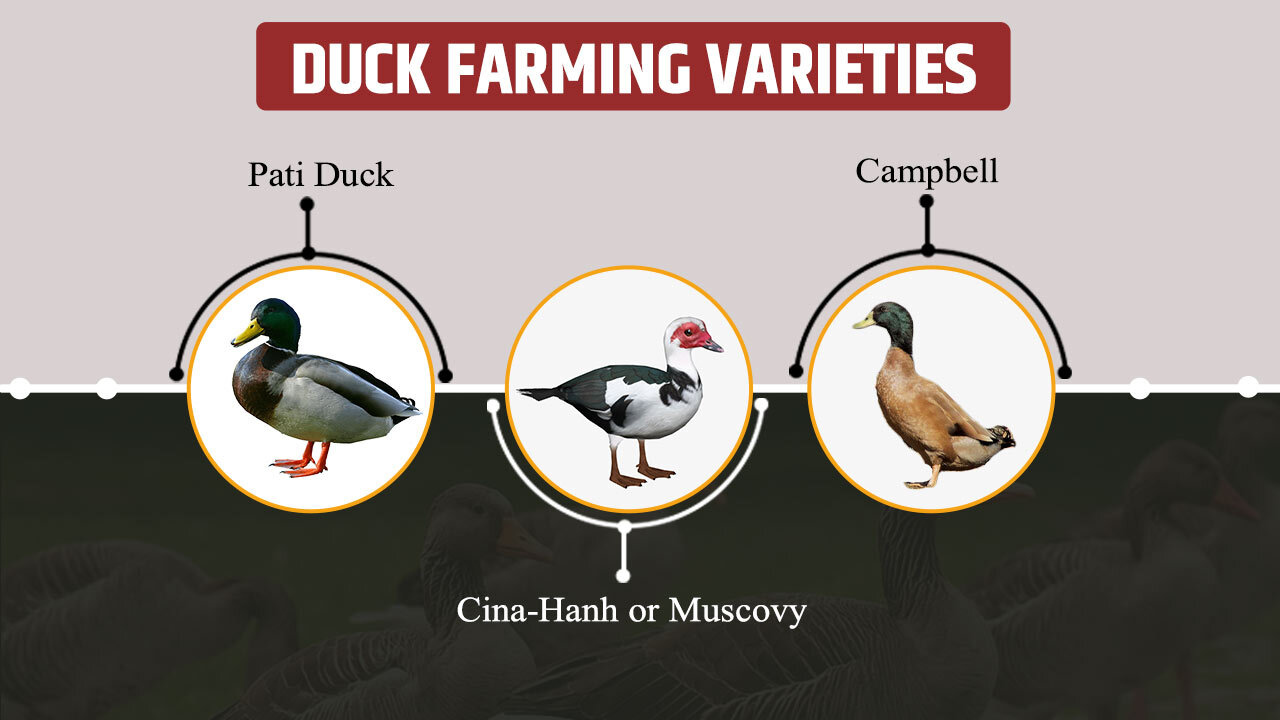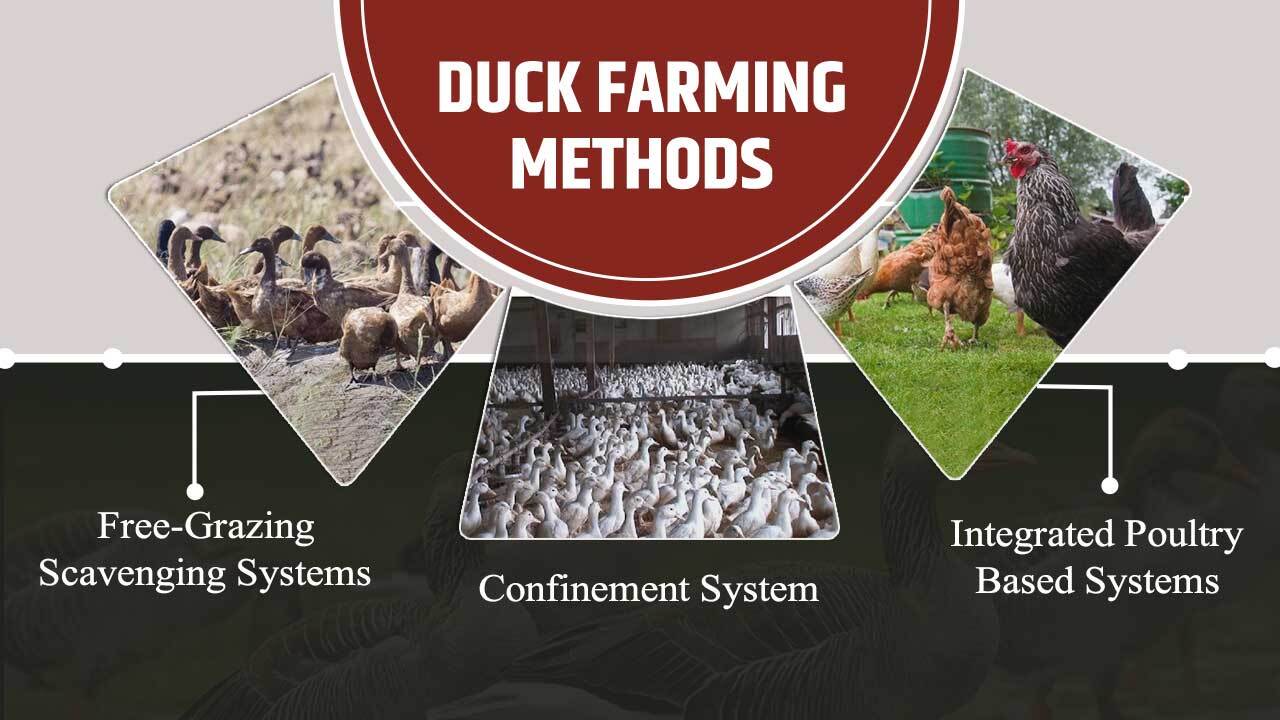Duck Farming Practice in India with Process, Methods and Benefits

Duck farming comes under the lucrative livestock agriculture around the globe because of its egg, meat and feather. Like chickens, ducks are raised for meat and eggs. Duck eggs are large, around 4.5% of a duck’s body weight, compared to a chicken which contains 3.3% egg weight. Moreover, ducks are more adaptable to produce eggs and meat, and more prolific than chickens. Moreover, they grow faster than chickens. That’s why; they are more popular in many countries.
In comparison with chickens, they need simple housing. This is the reason duck poultry farming has an important place in India. They produce approximately 10% of India’s poultry farming and contribute around 7 to 8% of the total eggs produced in the country.
Duck Production in India
There is the process of farming for ducks with information on how to do duck farming.
Farm size
You must examine the farm size while farming, which is determined by the number of birds. Larger commercial operations may have 50,000 to 100,000 ducks every batch, whereas smaller farms may only have 6,000 ducks per batch.
Selection of Breed
After finding out the size of the farm, the right decision needs to be taken for breed selection to generate a profitable commercial duck farming business. Whether a farmer raised ducks for meat or eggs. For example, the white farm duck is the most popular and best breed for egg-laying in India, while they are also known as the most profitable breed for their good quality of meat production.
Duck Gender Determine
Identifying the sex of a newborn duck is not difficult. As the duck’s tail lifts, press its back end with your thumb. If you see a thorn-like penis, it is a male duck. Otherwise, it will be a female duck. Male ducks are easy to recognize by their tails. Curved tail feathers of male ducks are the easiest sign or thing to identify male ducks.
Choose the Category of Duck Breed
1. Raising Ducks for Meats
If you are raising ducks for meat, you can select Meat-producing duck breeds in various varieties. The varieties include Pekin, Aylesbury, Cayuga, Khaki Campbell, Saxony, Silver Appleyard, Swedish Blue, Buff Orpington, Swedish Yellow, Grass and Crested etc.
2. Duck Farming for Eggs
Are you planning to start duck farming for eggs? Pekin, Welsh Harlequin, Khaki Campbell, Abacot Ranger, Indian Runner, Buff Orpington, Alabi, Magpie, Rouen, Hook Bill, Bali, Shetland and Ancona etc are well-known for their high egg production.
3. Duck Farming for Egg and Meat
If you are searching for duck farming for both, then Khaki Campbell, Indian Runner, and Ruel Kagua ducks are good choices for both eggs, and meat is the best breed for you.
Along with this, you should also have good knowledge of raising ducks for farming. Following, we are going to describe duck rearing. Have a look.
What is Duck Rearing in India?

Duck rearing is a rich source of subsistence for farmers; therefore you need safe houses to protect ducks from foxes, mongoose, teats, natural calamities and thieves. They cannot tolerate severe temperatures. So you have to pay attention to the temperature of the house. You should keep the following things in mind while building a house.
1. Selection of place
When you are thinking of doing the small scale duck farming business, you need a small duck farm. On the contrary, doing this business on a large basis requires a big duck farm. This house should be lighted and airy and, it will be located away from the dense city area. The house will be open so that light and air can pass through the space outside the house. It is different from a poultry farm, so diseases cannot be easily contaminated. Hence, a tall, narrow and rectangular house is suitable for ducks.
2. Temperature Required
Mainly a temperature of 12.8C (55F) – 23.9C (75F) is suitable for ducks. And, temperatures as low as 4.4C (40F) and over 37.8C (100F) are harmful.
3. Suitable Humidity Requirement
Natural weather is generally suitable for ducks’ physical development, egg production and hair growth. Further artificial environments harm egg production. For example, 70% humidity is suitable for ducks. However, less than 30% moisture causes hair fall, and more than 70% humidity causes coccidia and worms to make them look unstable. Then we have to dry the garbage and ventilate the house.
4. Light (Artificial) Requirement
Artificial light helps ducks with physical development and egg production. Ducks need artificial light at night at 6 weeks of age. As a result, they eat a lot, and they grow easily. Egg-laying ducks need 14-16 hours of light a day. For this, a 60-watt bulb is needed for an area of 300 square feet. However, broiler ducks require full night lighting.
5. Suitable Ventilation
For suitable ventilation, 40% of the walls require bamboo sticks or wire mesh fencing so the wind can move freely through the house.
6. Floor Requirement
We have to ensure that the floor of the house is not wet and the mouse cannot enter the house. Ducks need net floors by 7-8 weeks, and older ducks need concrete floors (roof floors).
7. Bed Preparation
In bed preparation, we have to spread the object (litre) on the floor, which can absorb the moisture. We can use a straw, rice husk and wood powder as litter.
8. Water Requirement
You should have access to a water source for raising ducks for commercial duck egg production. And you require sufficient pure drinking water for duck rearing.
9. Feeding
Ducks should be fed Waterfowl Starter Crumble, a mixture specially formulated for their growth and development. Chick starters can be used as a substitute with caution. If a chick starter is used, you must offer a niacin supplement in the feed or water.
10. Incubation Period
The incubation period in a duck is 28 days longer than that of a chicken. Therefore, disease-free ducks should be procured from reliable sources or a government agency.
11. Secure Health
To get the best developmental and health efficiency, commercially produced food should be used. Turtles, owls, raccoons, hawks, skunks, cats and dogs are just a few predators that can harm your flock. So keep your ducks in a predator-proof cage.
Duck Farming Varieties in India

More than 100 duck varieties are available in India, but we are describing some Indigenous or Desi duck varieties.
A. Pati Duck
Pati duck is the indigenous duck variety of Assam. Annual egg production of its husband duck is 60 to 80 eggs. Desi ducks have a slow growth rate and are around 200-240 days old at first spawning.
B. Cina-Hanh or Muscovy
The Muscovy duck is the most popular domestic animal in China for its meat. The average number of eggs laid by China is found to be 15, 36 and 56 by 40, 52 and 72 weeks of age, respectively. Annual egg production ranges from 50 to 60 numbers.
C. Campbell
The Khaki Campbell (KC) duck starts growing at 120 to 130 days, with an annual egg production of 300 eggs per duck. The average weight of its eggs is 60 grams.
Duck Farming Methods

Here, you can find three methods of duck farming.
1. Free-grazing scavenging Systems
Free-grazing scavenging means ducks are permitted to roam freely rather than being contained. A basic system is still extensively used as a traditional combined duck farming method in the Mekong Delta.
2. Confinement system
The confinement system method is used when adequate floor space at each stage of the growth of ducks. It is a typical practice in the Mekong Delta to raise exotic and uncommon ducks during the dry season and thicken meat ducklings.
3. Integrated poultry-based systems
Under this system, the birds are kept under intensive systems. For proper ducks hatching, manufacturers often use a combination of traditional processes and incubators.
Benefits of Duck Farming
- Duck farms are highly cost-efficient as they are comparatively less expensive than raising chickens.
- Moreover, ducks require less space for their rearing as they have a shorter lifespan, and the ducks grow faster, providing tangible benefits to the farmers.
- Interestingly, it is also easier for farmers to feed ducks because they can subsist on various low-cost foods, including corn, copra, cassava, corn, rice, and fruit, among other grains.
- In addition, they obtain food such as aquatic weeds, green beans, algae, fungi, maggots, earthworms, snails and other types of insects.
- One of the major benefits of raising ducks is their egg-laying cycle at night or in the morning. This allows the farmer to collect fresh eggs every morning.
For further information regarding intensive duck farming, and domestic duck price, stay tuned with TractorGuru.
Here, you can also get the best duck for farming and duck farming guide for beginners.
FAQS
Que. Is the modern duck farming business plan profitable?
Ans. Yes, because duck meat and eggs are in high demand in international as well as in domestic markets.
Que. Is duck the better option than chicken?
Ans. Duck meat is richer in most vitamins than chicken meat. So the answer is yes, duck is the better option than chicken.
Que. How long does a duck take time to grow?
Ans. You can fully grow ducklings in about 30 days.
Que. What products do we get from ducks?
Ans. Ducks offer a variety of products for marketing: eggs, meat, feathers and foie.
Que. What are duck farming tips for management?
Ans. You should always make sure that there is enough clean water in the house while duck farming.
Related Posts:



